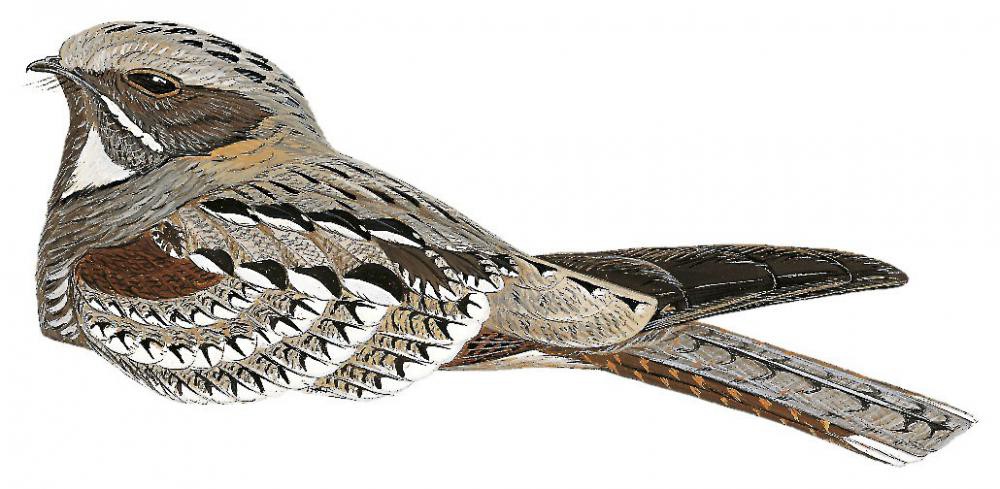Philippine Nightjar / Caprimulgus manillensis

Philippine Nightjar
SCI Name:
Protonym: Caprimulgus manillensis Trans.Zool.Soc.London 9 p.159
Taxonomy: Caprimulgiformes / Caprimulgidae / Caprimulgus
Taxonomy Code: phinig1
Type Locality: Manila.
Author: Walden
Publish Year: 1875
IUCN Status: Least Concern
DEFINITIONS
CAPRIMULGUS
(Caprimulgidae; Ϯ European Nightjar C. europaeus) L. caprimulgus nightjar < capra nanny-goat < caper, capri billy-goat; mulgere to milk; “Those called goat-suckers ... enter the shepherds’ stalls and fly to the goats’ udders in order to suck their milk, which injures the udder and makes it perish, and the goats they have milked in this way gradually go blind” (Pliny X, lvi (ed. Rackham 1983)); this unfounded rustic superstition was for long associated with the European Nightjar; "NIGHT-HAWK (C. popetue). I have noticed, when skinning this bird, that the male, in spring, exhales a strong hircine odor. If this is common to all birds of the family, it may have added apparent reason to the superstition from which the family name is derived." (Coues 1874); "102. CAPRIMULGUS. Rostrum incurvum, minimum, subulatum, basi depressum. Vibrissæ ad os serie ciliari. Rictus amplissimus. ... Caprimulgus genere differt ab Hirundine, uti Strix a Falcone, Phalæna a Papilione." (Linnaeus 1758); "Caprimulgus Linné, Syst. Nat., ed. 10, 1, 1758, p. 193. Type, by tautonymy, Caprimulgus europaeus Linné (Caprimulgus, pre-binomial specific name in synonymy." (Peters, 1940, IV, p. 196). Linnaeus's Caprimulgus, the final avian genus listed in his historic ground-breaking work, comprised two species (C. europæus, C. americanus).
Synon. Allasma, Capripeda, Climacurus, Cosmetornis, Creapyga, Crotema, Diaphorasma, Eximiornis, Hypsiphornis, Macrodipteryx, Nyctichelidon, Nycticircus, Nyctitypus, Nyctipornis, Nyctisyrigmus, Nyctivociferator, Phalaenivora, Rossornis, Scotornis, Semeiophorus, Stelidopterus, Vociferator.
caprimulgus
L. caprimulgus nightjar < capra nanny-goat < caper, capri billy-goat; mulgere to milk (cf. Gr. αιγοθηλας aigothēlas goatsucker).
manilla / manillae / manillensis
Manila, Luzon, Philippines.
● ex "Pie-griesche de Manille" of Brisson 1760 (syn. Artamus leucorynchus).
● ex “Petite caille de l’isle de Luçon” of Sonnerat 1776, and “Manilla Quail” of Latham 1783 (syn. Coturnix chinensis lineata).
● (Forster 1781) ex “Merula solitarius philippensis” of Brisson 1760 (syn. Monticola solitarius philippensis).
● (Boddaert 1783) ex “Merle solitaire de Manille” of d’Aubenton 1765-1781, pl. 636 (syn. Monticola solitarius philippensis).
● (J. Gmelin 1789) ex “Merula solitarius manillensis” of Brisson 1760, “Merle solitaire de Manille” of d’Aubenton 1765-1781, pl. 564, fig. 2, and pl. 636, and “Pensive Thrush” of Latham 1783 (syn. Monticola solitarius philippensis).
● ex “Pelican brun de l’isle de Luçon” of Sonnerat 1776, and “Manilla Pelican” of Latham 1785 (syn. Pelecanus philippensis).
● ex “Calao de Manille” of d’Aubenton 1765-1781, pl. 891, and de Buffon 1770-1786, and “Manilla Hornbill” of Latham 1781 (Penelopides).
● ex “Courlis brun de l’isle de Luçon” of Sonnerat 1776, and “Manilla Ibis” of Latham 1785 (syn. Plegadis falcinellus).
● ex “Gobe-mouche à gorge jaune de l’isle de Luçon” of Sonnerat 1776, and “Yellow-throated Fly-catcher” of Latham 1783 (unident.).
● Erroneous TL. "the Manillas" (= South America); ex "Sarcelle de l'Isle de Luçon" of Sonnerat 1782 (syn. Callonetta leucophrys).
● Erroneous TL. Luzon, Manila (= Cape of Good Hope); ex “Pic verd de l’isle de Luçon” of Sonnerat 1776, and “Manilla Green Woodpecker” of Latham 1782 (syn. Dendropicos griseocephalus).
● Erroneous TL. Philippines (= Ceylon); ex “Perruche à collier couleur de rose” of de Buffon 1770-1783, and “Rose-ringed Parrakeet” of Latham 1781 (subsp. Psittacula krameri).
UPPERCASE: current genus
Uppercase first letter: generic synonym
● and ● See: generic homonyms
lowercase: species and subspecies
●: early names, variants, mispellings
‡: extinct
†: type species
Gr.: ancient Greek
L.: Latin
<: derived from
syn: synonym of
/: separates historical and modern geographic names
ex: based on
TL: type locality
OD: original diagnosis (genus) or original description (species)












